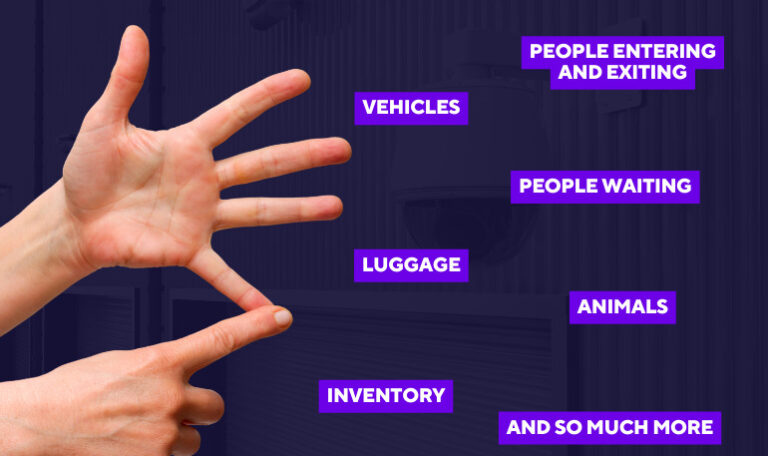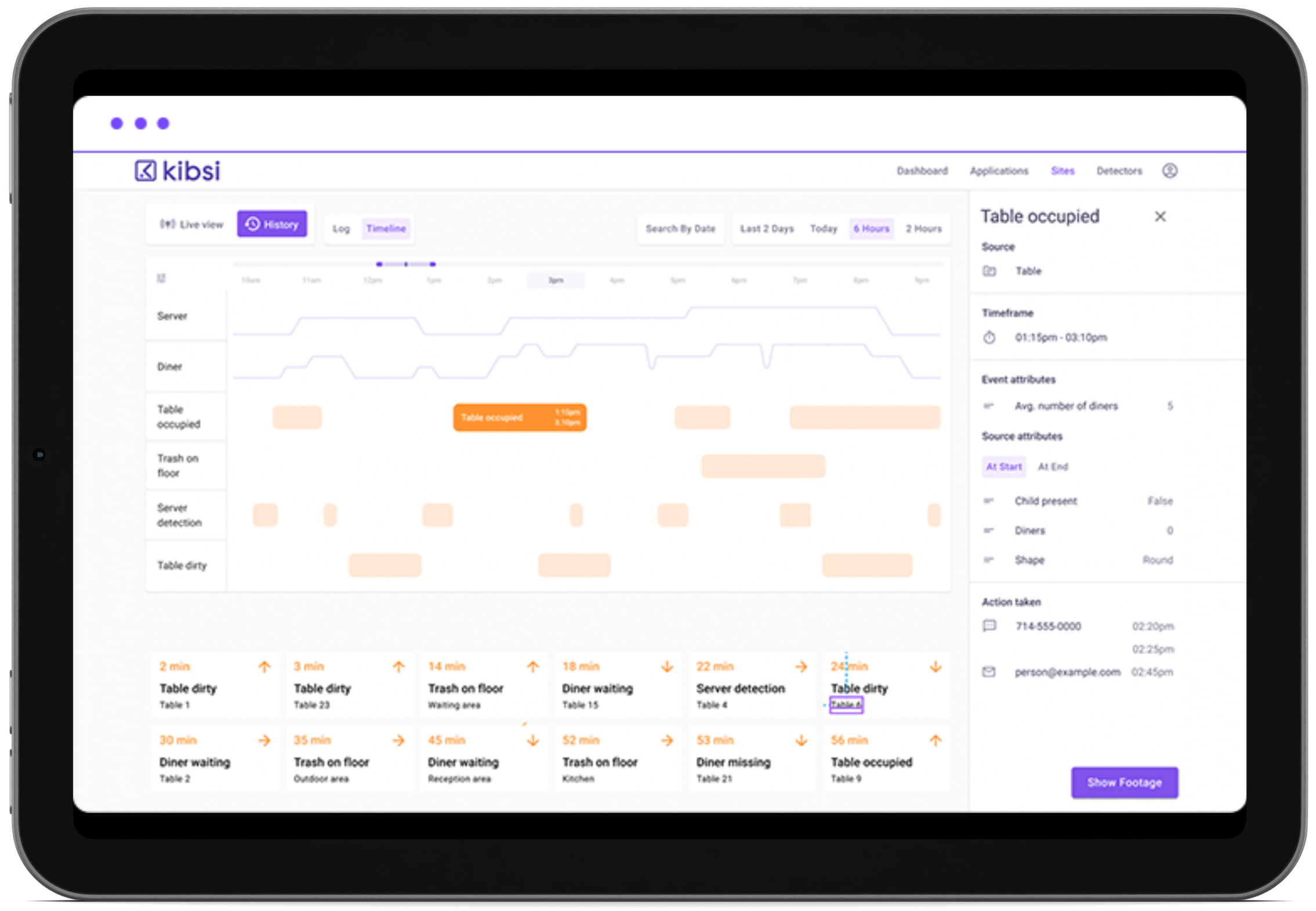Introduction: Navigating the AI Revolution with Computer Vision
In today’s fast-paced business environment, Artificial Intelligence (AI) is no longer just a buzzword but a critical tool reshaping how we do business. From small startups to global corporations, AI is unlocking new possibilities, driving efficiency, and creating new paradigms in customer engagement and operational excellence. At the heart of this AI revolution is Computer Vision, a dynamic and accessible subset of AI that is transforming industries by giving machines the power to ‘see’ and ‘interpret’ the world.
As a leader in the Computer Vision arena, Kibsi stands at the forefront of this transformative journey. We understand that while AI might seem like a complex labyrinth to many, Computer Vision provides a clear and tangible entry point. It leverages existing technology infrastructure – like video cameras – seamlessly integrating with your current operations, thus avoiding the long lead times commonly associated with AI initiatives.
AI and Computer Vision – A Primer for Businesses
What is AI?
Defining AI: A journey from theoretical concept to a practical toolkit transforming business operations across the globe.
The Business Impact of AI: Beyond mere automation, AI represents a paradigm shift in data analysis, decision-making processes, and customer interactions.
Introducing Computer Vision
Understanding Computer Vision: It’s the subset of AI where machines are taught to interpret and understand the visual world.
Complementing AI Technologies: While AI encompasses a broad range of technologies, Computer Vision specifically focuses on visual processing, differentiating it from other AI branches like natural language processing or machine learning.
Seeing is Believing: Computer Vision in Real-World Applications
- Logistics: Streamlining operations with real-time tracking and automated inventory management, reducing errors, and enhancing efficiency.
- Manufacturing: Implementing defect detection and real-time monitoring to maintain quality control and optimize production lines.
- Transportation: Enhancing safety and operational efficiency through vehicle tracking, condition monitoring, and automated traffic management systems.
- Zoological Management: Innovating in animal care and habitat management through behavior analysis, population tracking, and enhancing visitor experiences.
As we delve into the intricacies of Computer Vision, it becomes evident that it’s more than just a technological advancement; it’s a strategic tool reshaping industries. Kibsi’s expertise in tailoring Computer Vision solutions for specific sectors like logistics, manufacturing, transportation, and zoos exemplifies the potential of AI to revolutionize traditional operations, making businesses not just more efficient, but also more attuned to the future. Stay tuned as we explore the strategic advantages of starting your AI journey with Computer Vision and how it can be a game-changer for your business.
The Strategic Advantage of Starting with Computer Vision
In the realm of AI, the adoption of technology can often seem daunting – a journey fraught with complex integrations and long implementation timelines. However, Computer Vision emerges as a beacon of accessibility and immediate value, particularly for industries like logistics, manufacturing, and transportation. Let’s explore how Kibsi’s Computer Vision solutions are proving to be a game-changer for businesses ready to embrace AI.
Accessibility and Immediate Benefits
Seamless Integration with Existing Systems: One of the most compelling aspects of Computer Vision is its ability to integrate with existing camera and surveillance systems. This integration means businesses can leverage their current investments, avoiding the need for extensive infrastructure overhauls.
Instantaneous Improvements: The impact of Computer Vision is immediate. From the moment it’s integrated, businesses begin to see enhancements in operational efficiency, accuracy in processes, and a noticeable reduction in costs. These changes are not just incremental; they are transformative, offering a competitive edge in fast-paced industries.
Case Studies: Success Stories of Early Adopters
- Manufacturing Precision: We’ve seen manufacturing firms dramatically enhance their quality control processes. With Computer Vision, these companies can monitor for defects at scale in real-time, ensuring only products of the highest quality reach their customers.
- Revolutionizing Logistics: In logistics, the story is about optimized efficiency. Companies have adopted Computer Vision for real-time tracking and management of inventory, leading to streamlined operations and reduced bottlenecks.
- Transforming Transportation: Transportation companies are using Computer Vision to monitor vehicle conditions, manage traffic flows, and enhance safety measures, showcasing a significant leap in operational efficiency and safety standards.
Why Computer Vision is the Ideal AI Starting Point
Lower Barriers to Entry: Computer Vision doesn’t demand a complete overhaul of existing systems. By utilizing the already-in-place camera infrastructure, it lowers the barrier to entry for AI adoption.
Faster Implementation and ROI: Unlike other AI initiatives that require significant setup and adjustment periods, Computer Vision projects can demonstrate tangible results in a much shorter timeframe. This speed to market means a quicker return on investment, a crucial factor for businesses.
Scalability and Flexibility: Kibsi’s Computer Vision solutions are designed to start small and scale as needed, accommodating the growth and evolving needs of businesses. This scalability ensures that companies of all sizes can harness the power of AI without the risk of overcommitment.
As we delve deeper into the world of AI and Computer Vision, it becomes clear that this technology is not just a futuristic concept but a present-day solution to many operational challenges.
Overcoming the Challenges of AI Adoption through Computer Vision
AI adoption, despite its apparent benefits, often faces hurdles, primarily centered around the complexity of integrating new technologies and the significant challenge of gathering, organizing, and leveraging the necessary data. However, Computer Vision, a subset of AI, offers a more straightforward path to integration, especially for sectors like manufacturing and logistics.
Common Barriers to AI Integration: Many businesses struggle with the enormity of data required for effective AI. There’s also apprehension about the technical expertise needed and the perceived disruption to existing processes.
The Straightforward Path of Computer Vision: Unlike other AI technologies that require extensive historical data, Computer Vision can start delivering value and ROI without pre-existing data sets. It’s an excellent tool for beginning to gather more meaningful data.
Overcoming Technical and Operational Challenges with Kibsi: Kibsi’s solutions are designed to be plug-and-play, integrating with existing camera systems and requiring minimal technical expertise. Our support extends beyond just implementation, ensuring that businesses can navigate and overcome any technical or operational hurdles they encounter.
Computer Vision in Action – Transforming Industries with Kibsi
In the dynamic world of industry, the applications of Computer Vision are as varied as they are impactful. Kibsi, with its pioneering Computer Vision solutions, is at the forefront of this transformation, bringing about significant operational improvements in logistics, manufacturing, and distribution. Let’s explore how Kibsi is revolutionizing these sectors through innovative applications.
In the realm of Shipping Automation, a Fortune 500 logistics company exemplifies the profound impact of Computer Vision. By implementing Kibsi’s solutions for automating the scanning of labels on incoming shipments, they have witnessed a remarkable transformation. The outcome is a substantial saving of thousands of man-hours annually, coupled with a significant boost in overall efficiency. This automation not only speeds up the process but also reduces the margin of error, setting a new standard in logistics efficiency.
Turning to Worker Safety & Optimization, Kibsi’s impact is vividly illustrated in the paper products manufacturing industry. A leading company in this sector has employed Kibsi to enhance worker safety by monitoring compliance and optimizing forklift operations. The result is a dual benefit: a safer working environment and a more streamlined operational process. This application of Computer Vision underscores Kibsi’s commitment to not just improving efficiency but also ensuring the well-being of the workforce.
In the world of distribution, Clean Invoicing & Delivery takes center stage. A major distributor has harnessed Kibsi’s Computer Vision technology to verify products and quantities during loading and unloading processes. This intelligent monitoring system has significantly improved accuracy in invoicing and delivery, leading to an impressive saving of around 9,000 worker hours per year. Such precision in inventory management is revolutionizing the way distributors operate, ensuring accuracy and efficiency from warehouse to delivery.
Lastly, in the manufacturing sector, particularly in the construction materials segment, Assembly Line Precision is a critical factor. A Fortune 500 manufacturer collaborates with Kibsi to detect abnormalities on the assembly line. The early detection of issues enables the company to preempt costly production micro-stoppages. This proactive approach not only saves expenses but also ensures a seamless manufacturing process, highlighting the crucial role of Computer Vision in maintaining and enhancing assembly line precision.
The shift to Computer Vision in business operations is more than just a leap into the future of technology; it’s a strategic investment. This move is not solely about integrating cutting-edge tools into existing systems; it’s fundamentally about realizing a significant return on investment (ROI). When businesses adopt Computer Vision, they are not just participating in a technological trend, they are investing in a tool that offers tangible benefits in both efficiency and cost savings.
ROI Potential with Computer Vision
The immediacy of Computer Vision’s impact is one of its most compelling attributes. Unlike some technological investments that take time to show their worth, Computer Vision quickly manifests its value.
This fast-acting nature of Computer Vision translates to a rapid and significant ROI for businesses. It offers a dual advantage: reducing operational costs while simultaneously improving overall efficiency.
The substantial and measurable benefits of Computer Vision make it an investment that businesses can rely on for immediate and long-term returns.
Statistical Data and Forecasts
To further understand the ROI potential of Computer Vision, we delve into specific data points and forecasts. These are not just arbitrary numbers but are backed by comprehensive industry studies and internal metrics.
These statistics shed light on how Computer Vision can streamline operations, leading to cost reductions and heightened operational efficiency.
By examining these figures, businesses can make informed decisions about the integration of Computer Vision, understanding its potential to enhance their bottom line.
Real-World Impact: Testimonials and Case Studies
Perhaps the most compelling evidence of Computer Vision’s ROI comes from those who have firsthand experience with its transformative power.
Hearing from a diverse array of industries, from manufacturing to logistics, provides insights into how Computer Vision can be tailored to meet various operational needs and challenges.
These testimonials and case studies offer a window into the real-world applications and benefits of Computer Vision, showcasing its role in revolutionizing business operations.
In sum, the decision to invest in Computer Vision is not just about keeping pace with technological advancements; it’s about making a strategic choice that yields substantial returns. Through its immediate impact on operations, backed by solid statistical evidence and real-world success stories, Computer Vision proves itself as an essential tool for businesses aiming to optimize their processes and maximize ROI.
Preparing for a Computer Vision-Powered Future
The journey into a Computer Vision-powered future might seem like uncharted territory for many businesses. However, with the right guidance and tools, this transition can be smooth and transformative. Here’s how companies can start their journey with Computer Vision and how Kibsi plays a crucial role in this transition.
- Starting the Journey with Computer Vision: The first step is understanding your business’s specific needs and how Computer Vision can address them. Whether it’s streamlining manufacturing processes, enhancing logistics efficiency, or improving safety protocols, identifying the areas of impact is key.
- The Role of Kibsi in Transition Support: Kibsi stands as a partner in this journey, offering not just technology but expertise and support. With a range of solutions tailored to different industry needs, Kibsi helps businesses seamlessly integrate Computer Vision into their existing operations.
- Actionable Steps for Integration: The practical steps to integrate Computer Vision include:
- Conducting an audit of current systems and processes to identify potential integration points.
- Engaging with a Kibsi expert to tailor a Computer Vision solution that meets your specific business needs.
- Implementing the solution with ongoing support and training from Kibsi, ensuring a smooth transition and maximum benefit realization.
Conclusion
As we’ve explored, Computer Vision is more than a technological innovation; it’s a pivotal tool in the AI revolution, shaping the future of business operations. For forward-thinking companies, starting with Computer Vision is not just a strategic move; it’s a step towards staying relevant and competitive in a rapidly evolving digital landscape. Kibsi’s solutions offer a pathway for businesses to harness the power of AI through Computer Vision, catalyzing operational efficiency and innovation.
Are you ready to embark on a transformative journey with Computer Vision? We invite you to explore the world of possibilities with Kibsi. Discover how our tailored solutions can revolutionize your business operations. Contact us for a demo or consultation and take the first step towards AI transformation. Visit our website for additional resources, case studies, and to learn more about our service offerings. Let Kibsi be your guide in navigating the future of business with Computer Vision.







